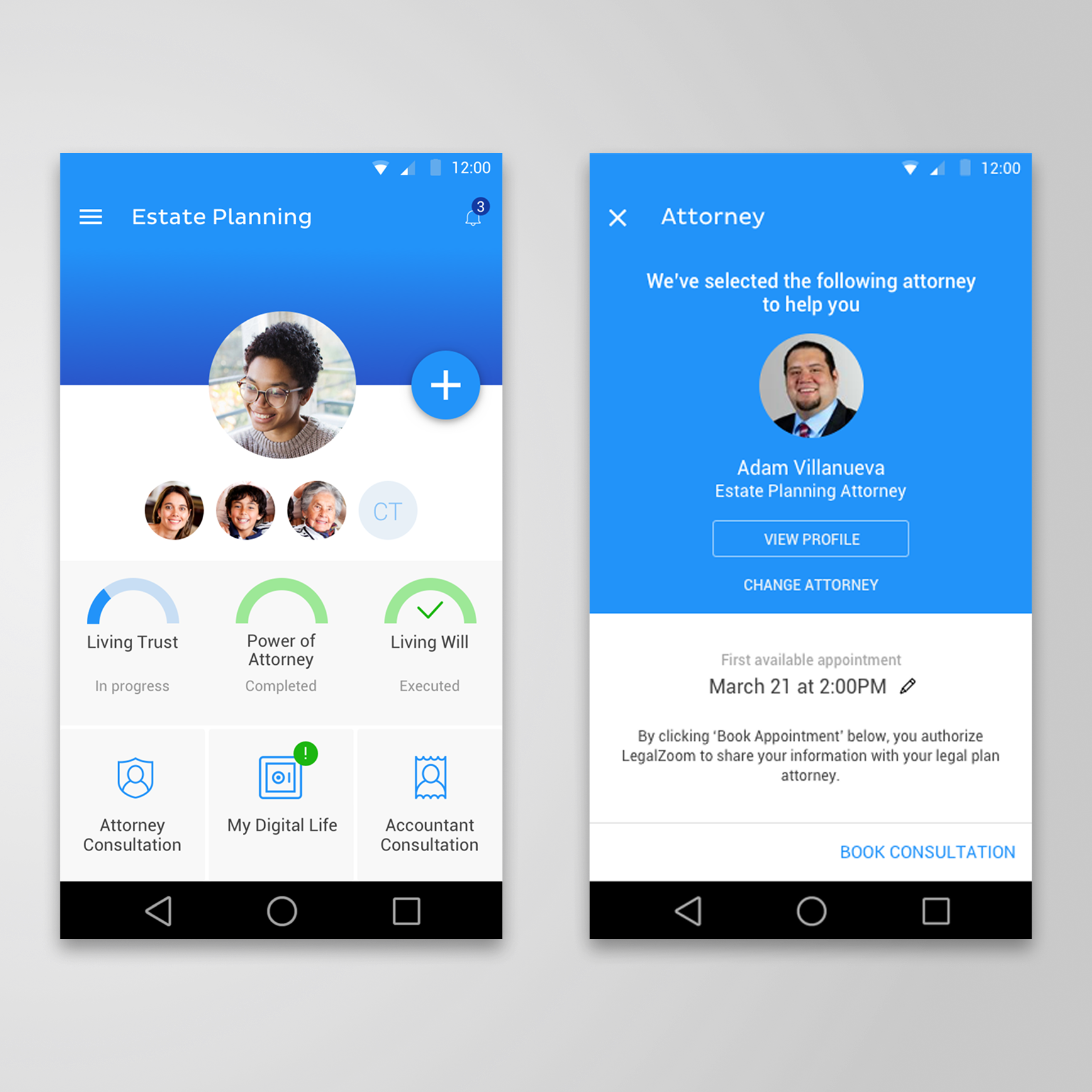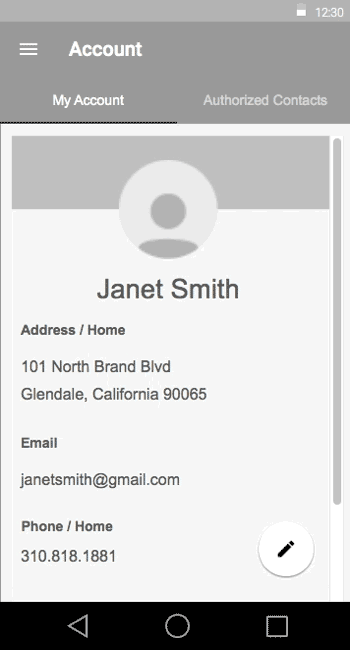LegalZoom Mobile App
A first-ever B2C app for LegalZoom, extending their Estate Planning offering to mobile platforms.
Customers tracked their estate plan completion, booked consultations, stored files online, and shared them with loved ones.
Above: Home page dashboard and attorney consultation booking confirmation screen. Comps by UI designer and my friend, Ade Nurasih.
TLDR Overview
Role: Senior UX Designer
Team: 2 UX Designers (iOS & Android), 2 UI Designers (iOS & Android) ,1 Product Director/Manager ,2 Developers (Android) ,2 Developers (iOS), 1 Copywriter, QA
Timeline: 8 months
Challenge: Extend LegalZoom’s services into mobile by designing a consumer-facing app that helped customers manage legal needs on the go.
Focus Areas: Information architecture, workflows, wireframes, prototypes, usability testing.
Impact
Produced a mobile-first concept that:
Improved adoption of legal services, simplified navigation, and increased customer engagement.
Tests showed stronger task completion and higher satisfaction with app usability.
My Task
As Senior UX designer, I led the UX design and strategy from end-to-end that would:
Take over the project that was started by another UX designer who left before I arrived.
Create Android UX assets: sketches, wireframes, flowcharts, screen flows, and prototypes as needed to support development.
Collaborate with the product owner to bring LegalZoom leadership’s vision to reality.
Partner with a visual designer who created comps while I created UX assets.
Perform UX Audit of the built app to ensure design adherence.
Launch the MVP of the app within agressive timelines of 8 months from start to launch.
Our Situation
It was 2015 and LegalZoom - a company offering legal advice and docs online - was excited to finally enter the mobile app space by offering its first B2C mobile app for iOS and Android. It was decided that since they already offered a desktop application for customers making estate plans, we’d create a feature-rich estate planning app on Android and iOS for digital estate plans available on the go.
My Actions
1. Takeover the Abandoned Project
Another UX designer started the job but left after a month. I took over his work, which was a single page of conceptual screens in Sketch.
Below: This was hardly ready to build with lots to figure out. One of the challenges was to create useful features for the user, but within limitations of decade-old legacy data models.
2. Hit the Ground Running
I was new and the schedule wouldn’t allow the team to do discovery, research, or requirements so my challenge was to start designing based on assumptions. Much remained to figure out on an aggressive schedule. Using Squid on my tablet, I started by sketching ideas and shared them during team brainstorm sessions.
Below: Early sketch flow explorations for adding a family member, showing questions to address with the Product Director.
3. Communicate the Flow with Clickable Flowcharts
One of the key features let users book consultations with attorneys or tax advisors. To show where these flows overlapped, and make it quick and easy to revise and keep current, I made clickable flowcharts.
4. Integrate Box File Storage
A partnership with Box Cloud storage would store user files and docs with back end services from BOX. Without an out-of-the-box front-end solution, so had to design our own.
As we progressed, I learned that flowcharts were hard for the team to follow, so I produced more screen flows instead of flowcharts.
5. Show Transitions and Animations through Prototypes
Our Product Director was unfamiliar with Android. I prototyped my ideas for the interaction model, which allowed us to test how they felt before developing them.
To make it easier to demo and share links with the team - I used Axure in desktop browser view instead of mobile, which would require special setups to view.
Below: A user can add and edit family members, check status of their documents, and clear notifications.
Below: A user can edit, delete, or add a new Authorized Contact from this screen.
6. Deliver Tons of End-To-End Features
The robust app contained 12 different sections and by the end I produced up to ~200 pages of wireframes, screenflows, and flowcharts in Axure for the development and product teams use.
7. Review Builds and Provide User Acceptance Testing (UTA) Feedback
During the final states of the build, I audited the UX and gave screenshot notes to the Product Director, to prioritize bugs and defects.
The Result
There were some bumps along the way, and it was a great learning experience for all while launching the app on time under the aggressive design and development timeline.
Shareholders were pleased by notable increases in:
Market Expansion / New Revenue Channels: The launch of the app unlocked a new mobile channel, enabling us to reach on-the-go users and small business owners previously underserved.
NPS / Brand Perception: By launching a modern, intuitive mobile app, we elevated LegalZoom’s perception as tech-forward and accessible. Shareholders and customers were impressed by the app’s on-the-go features for booking attorney and tax consultations, while accessing their estate planning documents from their pocket.
Operational Efficiency / Cost Savings: The app streamlined booking attorney and tax consultations that previously required customer service intervention, reducing call center volume and increasing self-service success.
Customer Retention / Engagement: App engagement led to higher retention rates, with mobile users exhibiting stronger loyalty behaviors like more frequent logins or repeat usage to view or track completion of their estate planning documents.
Below: All final comps by Ade Nurasih, visual designer.
My Takeaway
Every project has its own challenges, and we all learned valuable lessons for next time. My takeways and learnings included:
An app designed without research to identify the user problems/needs will face challenges.
In addition to an intuitive front-end, proper back end-database integration will greatly improve the user experience. Users reviewing the app complained it did not recognize their existing accounts, and they had to re-enter information.
I further mastered my skills in Axure.
How and where to simplify documentation and annotation for the product and development team.


